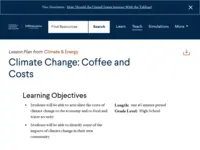Climate Change: Coffee and Costs
https://education.cfr.org/teach/lesson-plan/climate-change-coffee-and-costs
https://education.cfr.org/teach/lesson-plan/climate-change-coffee-and-costs
Council of Foreign Relations
This lesson explores the impacts of climate change on food, water, and infrastructure through the coffee industry. Students then relates this back to their communities.
This learning activity takes one 45 minute class period.
Learn more about Teaching Climate Literacy and Energy Awareness»Grade Level
Online Readiness
Topics
Energy Literacy
This Activity builds on the following concepts of Energy Literacy.
Click a topic below for supporting information, teaching ideas, and sample activities.
Notes From Our Reviewers
The CLEAN collection is hand-picked and rigorously reviewed for scientific accuracy and classroom effectiveness.
Read what our review team had to say about this resource below or learn more about
how CLEAN reviews teaching materials
Teaching Tips | Science | Pedagogy |
Technical Details
Teaching Tips
- Consider giving students the creative freedom to decide how they will present material in step 5 to the class. This may help engage students who struggle with the large amount of reading material in this lesson. In addition, educators may wish to research local impacts before completing step 5 in class since impacts will differ depending on location.
- For assessment, the lesson provides a workshop and suggests that students complete the first two parts at home and the final part in class.
- All three worksheet sections could be done at home and the lesson could be taught using a flipped classroom model. This would open up the entire class period to discuss and engage in the content of the lesson rather than ask students to do work they could do independently in a group.
About the Content
- In this resource, students learn to articulate the costs of climate change to the economy, and to food and water security by using the coffee industry as a case study. Students also identify some of the impacts of climate change in their own community.
- This resource articulates the economic costs of climate change as well as a few adaptations for food and water security. It briefly introduces many examples of climate change threats to industry, and can be used as a good background resource for students who are just becoming familiar with the climate crisis.
- The greatest strength of this lesson is that it includes timely and relevant material (2022-2024) to showcase the very current issue of climate change, which helps to dispel the myth that it is a future problem.
- The science included in this resource is accurate and sound. There are several links to peer-reviewed studies that provide more information on how the information was created.
- Passed initial science review - expert science review pending.
About the Pedagogy
- This introductory lesson uses a video and two articles, and a worksheet to engage students. The articles include images and interactive maps to teach students about the threats of climate change to small and large economies as well as city infrastructure.
- This lesson includes a large amount of information, and each section within the CRF articles can be used for a stand-alone discussion. Teachers may need to reduce the amount of reading based on student reading levels and abilities.
- This is a lesson on climate change impacts, which can be traumatic for students. Consider following-up with the CLEAN mental health activities to provide a way for students to process the information included in this lesson.
- The reading that focuses on adaptation can help emphasize helpful actions to counter the impacts. To further counter the negativity, considering adding a class discussion of solutions.
- The impacts described may connect with students, making it more relevant, and the lesson effectively addresses the far-reaching implications of climate change, which is valuable for student understanding of the gravity of climate change.








